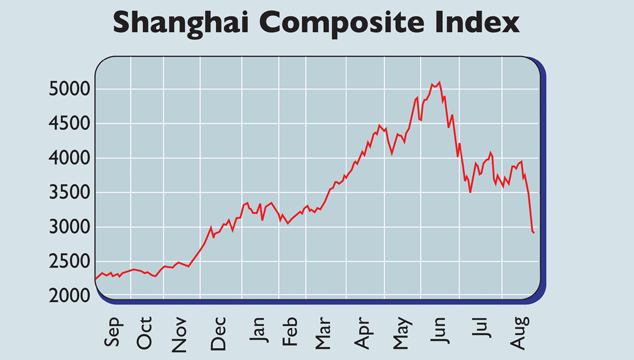
Global stockmarkets remained volatile after Black Monday, which saw some of the nastiest daily falls since the global financial crisis. On Tuesday, China’s central bank, the People’s Bank of China, tried to cheer investors by adding liquidity to the system. It cut interest rates for the fifth time in nine months and further reduced the Reserve Requirement Ratio (RRR), the amount of cash banks must set aside rather than lend out. But the move failed to halt another decline on Wednesday, when the Shanghai Composite Index fell by 1.3%. That sealed the worst five-day fall since 1996, and unsettled European markets again.
The turmoil has prompted many investors to put back their expectations of a US interest rate hike. Barclays, for instance, now reckons the first hike in almost a decade will come in March 2016, not next month. Ray Dalio, head of Bridgewater, a $200bn hedge fund group, said the US Federal Reserve would now ease monetary policy, restarting quantitative easing (QE), or money-printing, instead of tightening.
What the commentators said
“It’s not over yet,” said Commerzbank; markets are still unusually fragile. China’s interest-rate cut was “an act of desperation given free-falling markets and the tepid response in the real economy to previous rate cuts”, as Alex Frangos said in The Wall Street Journal. So it’s no wonder investors remain nervous, but the “stench of crisis” may soon dissipate. There are signs the economy is perking up again.
Far less encouraging, however, is the apparent return of the “Greenspan put” to the US, said James Saft on Reuters: the belief, nurtured by 1990s Fed chairman Alan Greenspan, that the central bank will always bail out markets by ensuring they have plenty of liquidity. Everyone is now saying they expect rates to stay on hold or even be cut, even though the economy looks healthy enough to cope.
This constant mollycoddling of investors encourages risk-taking and the formation of bubbles, continued Saft. “Silly people do silly things with money because they believe the Fed has their back.” Putting off the downswing in a cycle risks a bigger collapse later. What’s more, stocks are already historically overpriced, which means their long-term returns from these levels will be lousy. It’s time the Fed allowed investors to grow up and make their own mistakes.